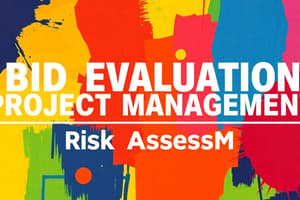Podcast
Questions and Answers
What percentage of an organization's revenue can procurement potentially be responsible for?
What percentage of an organization's revenue can procurement potentially be responsible for?
- 50%
- 25%
- 70% (correct)
- 90%
What is a key aspect of supplier synergies in modern procurement?
What is a key aspect of supplier synergies in modern procurement?
- Limiting the number of suppliers to streamline management.
- Avoiding long-term contracts to maintain flexibility.
- Focusing solely on the lowest price to maximize cost savings.
- Emphasizing supplier visibility and value beyond just the price. (correct)
According to the information, what percentage of organizations believe that digital transformation will change service delivery?
According to the information, what percentage of organizations believe that digital transformation will change service delivery?
- 65%
- 50%
- 85% (correct)
- 75%
How does digital transformation impact procurement?
How does digital transformation impact procurement?
Which of the following describes a shift in focus regarding supplier relationships?
Which of the following describes a shift in focus regarding supplier relationships?
In risk management, what does transparency in procurement systems ensure?
In risk management, what does transparency in procurement systems ensure?
According to the information provided, what percentage of procurement leaders have complete supply chain visibility?
According to the information provided, what percentage of procurement leaders have complete supply chain visibility?
What is the primary goal of proactive planning in risk management?
What is the primary goal of proactive planning in risk management?
Which of the following is critical when defining procurement objectives?
Which of the following is critical when defining procurement objectives?
Why is resource alignment important in procurement?
Why is resource alignment important in procurement?
What is the potential downside of outsourcing?
What is the potential downside of outsourcing?
How do procurement choices impact project timelines and budgets?
How do procurement choices impact project timelines and budgets?
What should one assess during the 'internal' phase of a 'make vs. buy' decision?
What should one assess during the 'internal' phase of a 'make vs. buy' decision?
Why is open tendering a beneficial procurement method?
Why is open tendering a beneficial procurement method?
Which procurement method is most suitable for specialized items requiring strong negotiation skills?
Which procurement method is most suitable for specialized items requiring strong negotiation skills?
What should be regularly monitored when using outsourcing as a procurement method?
What should be regularly monitored when using outsourcing as a procurement method?
What does risk management in procurement involve regarding suppliers?
What does risk management in procurement involve regarding suppliers?
What does the 'contractual' aspect of risk management involve?
What does the 'contractual' aspect of risk management involve?
Which actions align with what is involved in the 'market' aspect of risk management?
Which actions align with what is involved in the 'market' aspect of risk management?
What factors influence the selection of an appropriate procurement method?
What factors influence the selection of an appropriate procurement method?
Which of the following is a key responsibility of a project manager in procurement?
Which of the following is a key responsibility of a project manager in procurement?
Why is documentation important in the procurement process?
Why is documentation important in the procurement process?
What is the primary purpose of assumptions in project management, according to PMI?
What is the primary purpose of assumptions in project management, according to PMI?
Which of the following is typically considered a project constraint?
Which of the following is typically considered a project constraint?
According to the PMBOK Guide, what are the six recognized constraints in project management?
According to the PMBOK Guide, what are the six recognized constraints in project management?
Flashcards
Impact of Procurement
Impact of Procurement
Procurement significantly impacts an organization's bottom line and can be responsible for 70% of revenue.
Digital Transformation in Procurement
Digital Transformation in Procurement
Organizations are adopting digital solutions to improve efficiency and transparency in procurement.
Supplier Relationships
Supplier Relationships
Focus shifts from price to long-term value and visibility in supplier relationships.
Risk Management Importance
Risk Management Importance
Signup and view all the flashcards
Transparency in Procurement
Transparency in Procurement
Signup and view all the flashcards
Supply Chain Visibility
Supply Chain Visibility
Signup and view all the flashcards
Proactive Planning
Proactive Planning
Signup and view all the flashcards
Defining Procurement Goals
Defining Procurement Goals
Signup and view all the flashcards
Resource Alignment
Resource Alignment
Signup and view all the flashcards
Balancing Act
Balancing Act
Signup and view all the flashcards
Strategic Methods
Strategic Methods
Signup and view all the flashcards
Decision Impacts
Decision Impacts
Signup and view all the flashcards
Make vs. Buy Decision
Make vs. Buy Decision
Signup and view all the flashcards
Internal Considerations
Internal Considerations
Signup and view all the flashcards
External Considerations
External Considerations
Signup and view all the flashcards
Open Tendering
Open Tendering
Signup and view all the flashcards
Direct Negotiation
Direct Negotiation
Signup and view all the flashcards
Outsourcing (Procurement)
Outsourcing (Procurement)
Signup and view all the flashcards
Supplier Risk Management
Supplier Risk Management
Signup and view all the flashcards
Contractual Risk Management
Contractual Risk Management
Signup and view all the flashcards
Market Risk Management
Market Risk Management
Signup and view all the flashcards
Selecting Procurement Method
Selecting Procurement Method
Signup and view all the flashcards
PM Role in Procurement
PM Role in Procurement
Signup and view all the flashcards
Record Keeping (Procurement)
Record Keeping (Procurement)
Signup and view all the flashcards
Compliance (Procurement)
Compliance (Procurement)
Signup and view all the flashcards
Study Notes
- Procurement's role in project initiation involves key decisions, strategies, and risk management.
- Procurement sets the stage for project success.
Impact of Procurement
- Procurement significantly affects the bottom line and can be responsible for 70% of revenue.
- Digital transformation is a key element, where 85% of organizations believe it will change service delivery.
- Supplier synergies include focusing beyond price and emphasizing supplier visibility.
- Smooth change management is crucial for procurement goals.
Key Procurement Changes
- Several important shifts are shaping procurement management
- Organizations are adopting digital solutions to improve efficiency and transparency.
- The focus is shifting from price to long-term value and visibility in supplier relationships.
- Effective change management is essential for achieving goals, and transparent systems optimize risk management.
Risk Management
- Optimizing risk management requires transparent procurement systems that reduce risk exposure.
- Transparency is essential for identifying and mitigating risks.
- Only 65% of procurement leaders have supply chain visibility.
- Proactive planning to prepare for unexpected disruptions is key.
Procurement Objectives
- Procurement objectives must be specific, measurable, and aligned with project and strategic goals.
- Resource planning should occur early, determining the types, quantities, quality, cost, and availability of resources.
Time and Cost
- Time and cost are critical, and procurement impacts both.
- Efficient procurement saves time and reduces expenses.
- Outsourcing offers expertise but can be costly.
- Open tendering reduces costs but extends timelines.
- Procurement choices shape project design; internal vs. external sourcing and outsourcing affect timelines and budgets.
Procurement Decisions
- When deciding on make versus buy, internal options should:
- Assess internal capabilities.
- Determine if resources exist in-house.
- Evaluate capacity, expertise, and potential conflicts.
- When deciding on make versus buy, external options should:
- Consider outsourcing benefits.
- Access specialized skills externally.
- Weigh costs and control factors carefully.
- Evaluate potential risks.
Methods
- Open tendering:
- Involves inviting public bids and promoting competition for fair pricing.
- Can be time-consuming and requires detailed specifications.
- Direct negotiation:
- Involves engaging directly with suppliers.
- Suitable for specialized items, is a quicker process, and requires strong negotiation skills.
- The method has limited competition.
- Outsourcing:
- Is when delegating to external providers.
- Allows access to specific expertise and focuses on core competencies.
- Requires close contract management and regular performance monitoring.
Risk Management Strategies
- Supplier:
- Assess financial stability.
- Evaluate performance history.
- Diversify supplier base.
- Mitigate disruptions.
- Contractual terms:
- Ensure clear terms and include dispute resolution.
- Enforce compliance, and review legal aspects.
- Market:
- Monitor price fluctuations
- Stay informed about supply chains, and adapt to changing conditions by using data analytics.
Selecting Procurement Method
- Choosing the right method depends on project complexity, cost, timelines, and regulatory requirements.
Project Manager Role
- Key responsibilities include:
- Defining requirements.
- Identifying key suppliers.
- Developing procurement plans.
- Negotiating contracts.
- Stakeholder communication.
Documentation and Software Use
- Documentation is maintained throughout the procurement process.
- Software is used to streamline the process.
- Record keeping maintains accurate records of transactions.
- Compliance ensures adherence to regulations.
- The audit trail creates transparency.
The 3 P's of Procurement
- People: stakeholders need information,
- Process: follow or create necessary processes,
- Paperwork: maintain thorough documentation.
Assumptions
- According to the PMI, an assumption is any project factor that is considered true, real, or certain without empirical proof.
- It is impossible to plan a project without assumptions.
- Spotting assumptions and implementing safeguards minimizes the impact on project delivery if proven false.
- All project assumptions pose a potential risk.
- Assumption analysis is critical in risk management planning.
Constraints
- Constraints are limitations on your project team, like budgets, timelines, and resources, with predefined limits.
6 Constraints in Project Management
- As per the PMBOK Guide, the six constraints are:
- Scope
- Schedule
- Risk
- Quality
- Budget
- Resources
Assessing Constraints
- Crucial to assess constraints, tolerances, who sets them, how project managers use them, and how stakeholders stay informed.
Example of Assumptions and Constraints
- A great supplier has financial issues, risking product delivery.
- If there are no mitigating responses, project owners may stop it to avoid resource waste.
- This situation falls outside their risk tolerance, emphasizing proactive mitigation for project success.
Resolving Issues
- To resolve the issue, find ways to mitigate risk or consider an alternative supplier.
- A reliable contingency plan reduces the impact, bringing the project risks within tolerance limits.
Key Takeaways
- Strategic Importance: Procurement is strategic and influences project success.
- Early Planning: Plan early in the initiation phase for efficient resource management.
- Risk Mitigation: Proactively address risks, mitigating supplier, contractual, and market uncertainties.
Studying That Suits You
Use AI to generate personalized quizzes and flashcards to suit your learning preferences.




